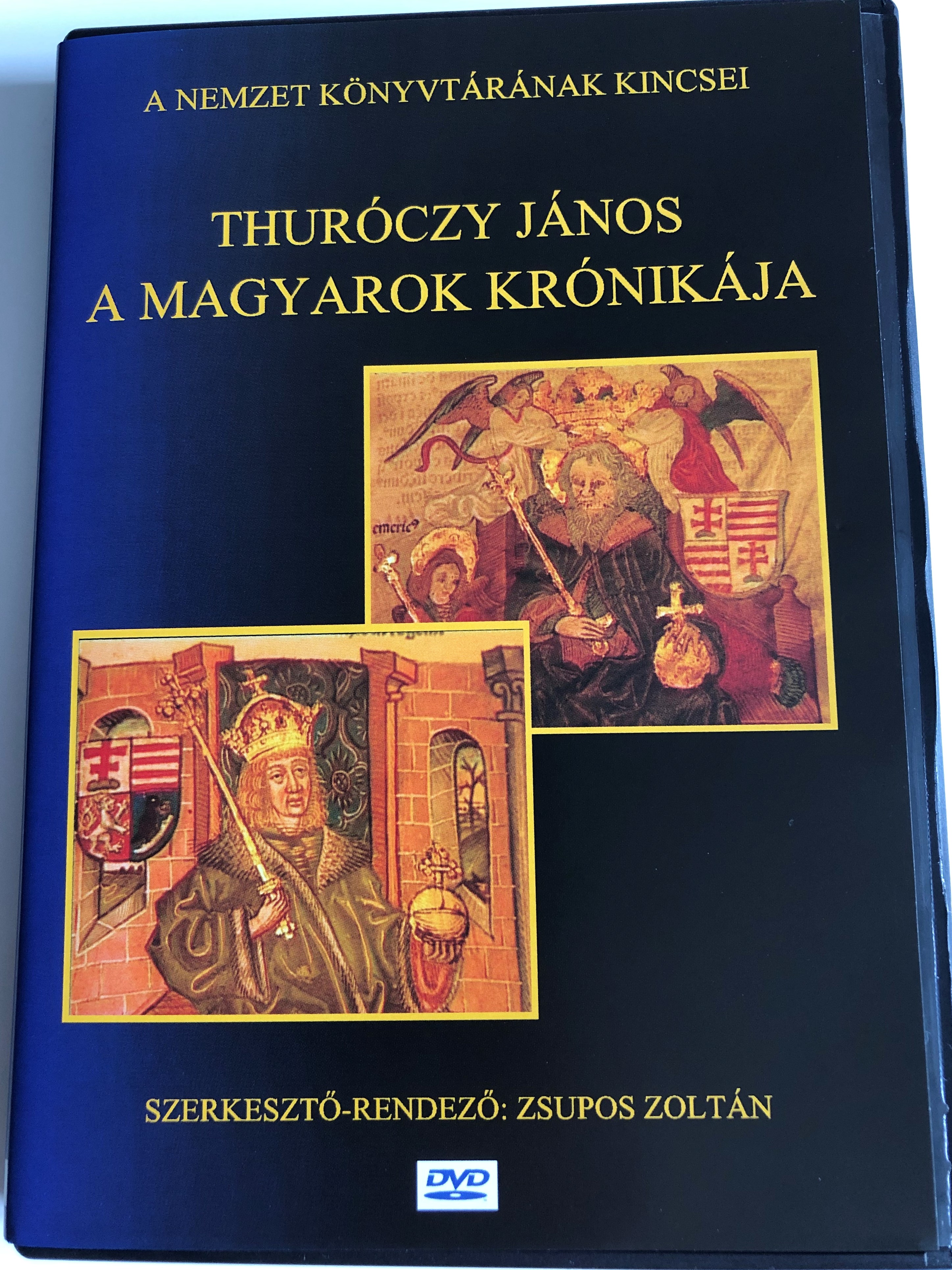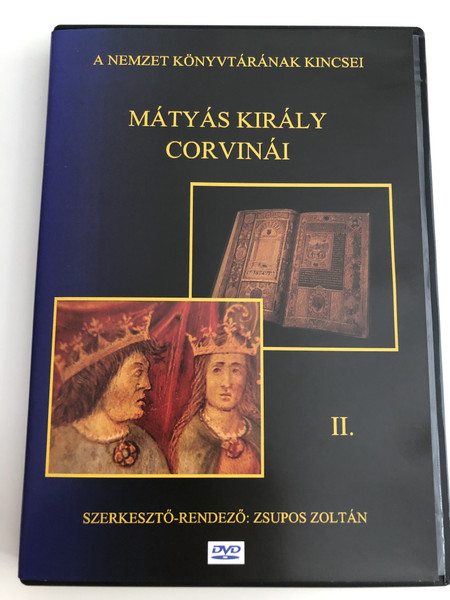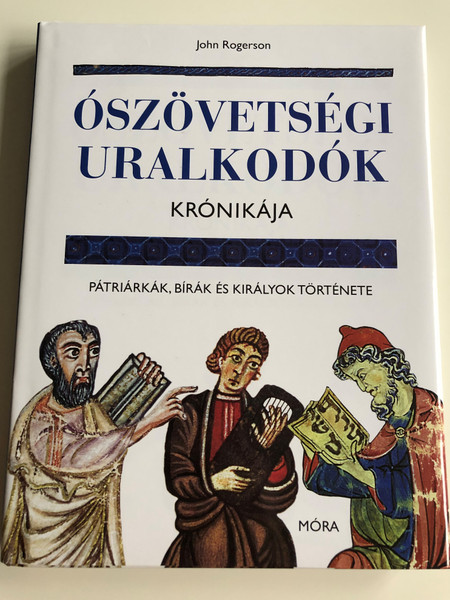Description
A magyarok Krónikája - Thuróczy János DVD Audio Book / Directed & Edited by Zsupos Zoltán / The Chronicle of the Hungarians / 3-part video presentation of the Thuróczy-chronicle / Chronica Hungarorum / BET0165 / A Nemzet Könyvtárának Kincsei / BET0165
REGION 2 PAL DVD
MADE IN HUNGARY
AUDIO: Hungarian
SUBTITLES: -
Runtime: 77 minutes
UPC 5099751734543
English summary:
Johannes de Thurocz (Hungarian: Thuróczy János; Slovak: Ján z Turca or Ján de Turocz, German: Johannes de Thurocz, variant contemporary spelling: de Thwrocz) (c. 1435 – 1488 or 1489), was a Hungarian historian[1][2] and the author of the Latin Chronica Hungarorum ("Chronicle of the Hungarians"), the most extensive 15th-century work on Hungary, and the first chronicle of Hungary written by a layman.
Thurocz's chronicle was written in three main parts:
- The first part is Thurocz's interpretation of a poem by Lorenzo de Monacis of Venice. It deals with the rule of King Charles II of Hungary, and was probably written on the initiative of Thurocz's superior Stephen of Haserhag (the general notary of the Royal court), or perhaps that of the country judge Thomas Drági. Physically, this part is attached to part c) below.
- Thurocz wrote the second part was written in 1486 and describes the deeds of Hungarian kings up to Louis the Great. This part in turn consists of three sub-sections:
- the so-called Hunnish chronicle based on old Hungarian chronicles (Chronicon Pictum, Buda Chronicle) and preserved manuscripts, in which Thurocz attempts to correct the errors of his predecessors;
- an interpretation of the history of the Hungarian Kingdom from 895 (arrival of the Magyars) until the rule of King Charles I of Hungary (1307 – 42);
- a history of part of the reign of Louis I of Hungary (reigned 1342 – 82), which arose through incorporation of a chronicle written by John of Küküllő.
- The third part describes events from the death of King Charles II the Small (died 1386) until the conquest of Vienna and Wiener Neustadt by King Matthias Corvinus in August 1487; this can be considered Thurocz's own original work, and was mostly written in early 1487. It was inspired by the famous historico-geographical lexicon Cosmographia by Aeneas Silvius Piccolomini and was based largely on existing diplomatic documents and letters. However, information from the Cosmographia was selected somewhat one-sidedly and haphazardly.
According to his own words in the work's dedication, Thurocz had no ambitions as an historian. In fact, his chronicle contains many errors and omits a number of significant events. Besides more reliable sources, the work relies extensively on oral tradition, folk songs and anecdotes, and contains many references to "miraculous" events and wonders.
The first editions of Chronica Hungarorum were published in 1488 in Brno, (Moravia) and Augsburg. Further editions followed over the following centuries in Frankfurt, Vienna, Nagyszombat and Buda.
Hungarian Summary:
Thuróczi János (1435? – 1489?) 15. századi magyar történetíró. Szentmihályi Turóczi Péter fia, a Magyar Királyság protonotariusa, azaz ítélőmestere. Részt vett 1470-ben a turóczi konventen, ahol a világi jegyző posztját töltötte be. Korának kiváló jogtudósa, szónoka és történetírója.
Zsupos Zoltán (Berettyóújfalu, 1959. június 30. –) történész, néprajzkutató.
1959-ben született Berettyóújfaluban, ott végezte általános és középiskoláit. A Kossuth Lajos Tudományegyetem Bölcsészettudományi Karán végezte tanulmányait. Munkahelyei: 1977-től 1979-ig, majd 1984-től 1986-ig a Bihari Múzeum, 1987–1990 között a Kossuth Lajos Tudományegyetem Néprajzi Tanszéke, 1990–1994 között az MTA Titkársága, 1994–2005 között a Duna Televízió, 2008-tól a Magyar Országos Levéltár. 2003-ban megkapta a Dercsényi Dezső-sajtódíjat
A Magyarok Krónikája E kötet magyar fordításban pontosan azt a szöveget közli, amely latinul 1488-ban gyors egymásutánban két nyomtatott kiadásban, Brünnben és Augsburgban is napvilágot látott: Thuróczy János krónikáját a magyarok történetéről a kezdetektől Mátyás királyig, valamint Rogerius gesztáját a tatárjárásról. Thuróczy János, az első világi történetíró Mátyás udvarában szolgált, előbb a kúria jegyzőjeként, majd élete végén a királyi személyes jelenlét bíróságán ítélőmesterként. Művének első részét (Károly Róbert uralkodásáig) a középkori krónikás hagyomány alapján készítette el, Nagy Lajos koráról saját művébe másolta Küküllei János egy évszázaddal korábbi krónikáját (mely csakis ennek köszönheti fennmaradását), a Nagy Lajostól Mátyásig terjedő korszak pedig Thuróczy eredeti alkotása. A magyarok krónikája középkori krónikairodalmunk összegző, legteljesebb lezárása. Rogerius mester itáliai származású pap, aki a pápai legátus kíséretének tagjaként került Magyarországra, s itt élte át a tatárjárás (1241-1242) véres időszakát. Siralmas ének a tatárok magyarországi pusztításáról című művét közvetlenül az események után írta, saját élményei alapján. A mű azonban távolról sem csupán élménybeszámoló, hanem objektív elemzéseket tartalmazó, oknyomozó történeti munka, középkori irodalmunk kiemelkedő alkotása. Fennmaradását szintén csak annak köszönhetjük, hogy elkészülte után közel negyed évezreddel Thuróczy János függelékként krónikájához csatolta és kinyomatta, hiszen nemhogy kézirata nem maradt fenn, de még csak egy utalás sem arról, hogy Thuróczy előtt bárki ismerte volna. A két mű együtt pedig olyan kötetet alkot, melyet fél évezrede Mátyás király is kezében tartott…


















